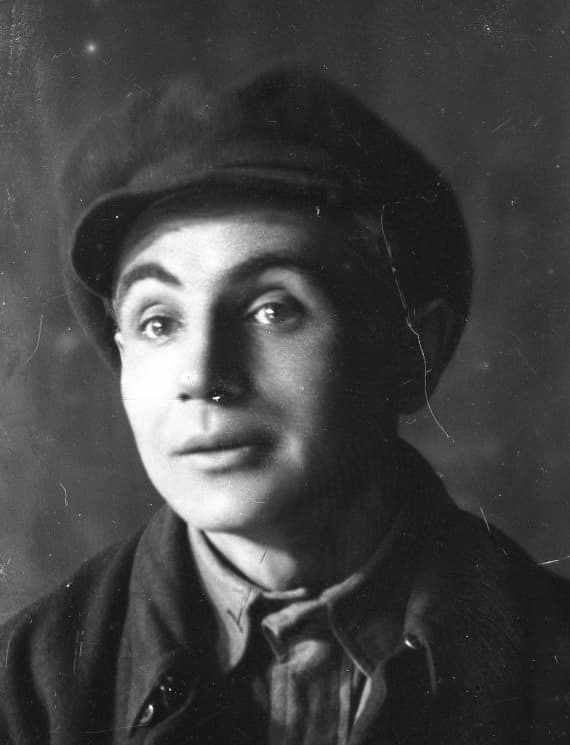Based on the play by Franz Grillparzer
Translated from German by Les Kurbas
Premier in Odesa: August 21, 1918
Premier in Kyiv: December 12, 1918
Director: Les Kurbas
Artist: Anatol Petrytskyi
Gregor, Bishop of Chalons – Hnat Yura
Athalus, His Nephew – Lev Piasetskyi
Leon, Cook’s Assistant – Les Kurbas, Favst Lopatynskyi
Cottwald, Count of Rheingau – Vasyl Vasylko
Edrita, His Daughter – Sofiia Manuilovych, Hanna Prokhorenko
Galomir, Her Fiancé – Stepan Bondarchuk
Gregor’s Caretaker – Yona Shevchenko
Overseer – Andrii Lisovskyi, Andrii Shchepanskyi
First Haiduk – Hnat Ihnatovych, Yurko Karas
Second Haiduk – Leonid Predslavych
Pilgrim – Volodymyr Kalyn
Franconian Chief – Ihor Khodzytskyi
Fisherman – Pavlo Dolyna
His Journeyman – Oleksandr Yurskyi
Beggars – Ihor Khodzytskyi, Mykola Mykhailovskyi, Yurko Karas, Leonid Predslavych
Cooks – Olena Rokytianska, Antonina Doroshenkova, Olesia Kravchenko, Natalia Kovharyna, Liubov Liuchik, Polina Niatko, Vira Viriko
Soldiers: Todir Krok, Leonid Predslavych
When creating the Young Theater, Les Kurbas wanted his actors to study and practice different styles and genres of stage acting. A new phase and test for the young team was the play Woe to Him Who Lies, in which the director, artist and actors paid much attention to the search for theatricality. Kurbas used the romantic play by Franz Grillparzer to study comedy in theater. He staged it in the form of commedia dell’arte, complete with slapstick, antics, stunts and improvisation.
It’s no coincidence that this play became part of the Young Theater’s repertoire. Kurbas spent a lot of his free time while studying in Vienna at the Burgtheater, where he came to admire the work of the famous Austrian actor Josef Kainz (who would become one of his favorites). These impressions from his youth led Kurbas to add Woe to Him Who Lies – in which Josef Kainz once played the lead role of Leon – to his repertoire.
After the premiere, as is often the case, the critics were sharply divided. One newspaper likened it to a play for preschoolers and said that the comedy was too far-fetched to evoke sincere laughter, although some scenes did have light natural humor. Writer and theater critic Mykola Voronyi was more categorical: “Grillparzer’s farcical and cleverly funny comedy Woe to Him Who Lies was performed in a fun way, but the excessive vulgarity and lack of appropriate light elegance gave the impression of bad taste.” Many other critics and spectators strongly disagreed with this and said that there was a lot of novelty, theatricality and youthful zeal in the show: “Kyiv hasn’t seen anything like Woe to Him Who Lies – it’s a dazzling and young rocket of buffoonery.”
Actor Stepan Bondarchuk recalled that every performance of Woe to Him Who Lies was sold out, with Kurbas proving that “the outstanding artist had no less skill in this difficult genre than in any other.”
According to the plot, Bishop Gregor of Chalons teaches everyone around him that one should live truthfully and not deceive anyone. When his nephew Athalus is captured by Count Cottwald, he is too stingy to part with his money. His cook Leon is ready to free the young man from captivity, but the virtuous bishop sets a condition: the rescue must happen without lies, otherwise he will send Athalus back. Leon accomplishes the task and returns home not only with the bishop’s nephew but also his future wife Edrita – the count’s daughter who helped him.
Critics noted the good assignment of roles. The main role of Leon was played brilliantly by Kurbas himself, who was called the “tuning fork” of the show. The young and clever cook was played by Favst Lopatynskyi, “whose subtle performance had a lot of thoughtfulness, feeling and genuine humor.”
Actor Vasyl Vasylko compared Kurbas’s energy and lightness as the witty and resourceful Leon to the energy of mercury – calling him “quicksilver.” Vasylko said that Kurbas’s improvisations were so unexpected and unpredictable that they threw them off every time, but at the same time added thrill and triggered accurate and quick reactions. Stepan Bondarchuk compared Kurbas’s and Lopatynskyi’s acting to the graceful play of dolphins in the warm sea, while Vasylko’s role as Count Cottwald reminded him of an annoyed wild bull.
Many scenes in the play elicited sincere laughter from the audience. Kurbas, who always crafted roles masterfully, adhered to the principles of commedia dell’arte and gave the actors much freedom and a broad field for improvisation – although it had to have a strong connection with the course of events and nature of the characters. Rude jokes, cheap stunts and laughter for the sake of laughter were not allowed: there had to be an iron-clad logic to everything. This experience didn’t come easy to the actors (they lacked experience in slapstick and antics), but Kurbas inspired everyone to work on creating the show zealously.
Artist Anatol Petrytskyi, who they called a magician of stage colors in the Young Theater, captivated both spectators and critics with his work. There was one concise and eloquent newspaper article: “The scenery was impressive and pleasantly novel. The theater was full.” Kurbas called Petrytskyi one of the best modern masters of costume and stage design. Actor Hnat Yura, who played the bishop, recalled how Petrytskyi “made colorful scenery of gold and black bordered tones that were quite far from reality. The background had a painted river with beautiful flowerlike fish on its waves, and he painted somewhat fantastic but picturesque castles and forest.”
When creating such bright and extraordinary performances as Woe to Him Who Lies and Vertep at the Young Theater, Kurbas said: “You will be captivated by the thirst for self-oblivion in the theater. Your life has become very sad, and you can’t do without a fairy tale. Philosophers, moralists and socialists are trying to make this story as instructive as possible. We want to make it as magical as possible.”

